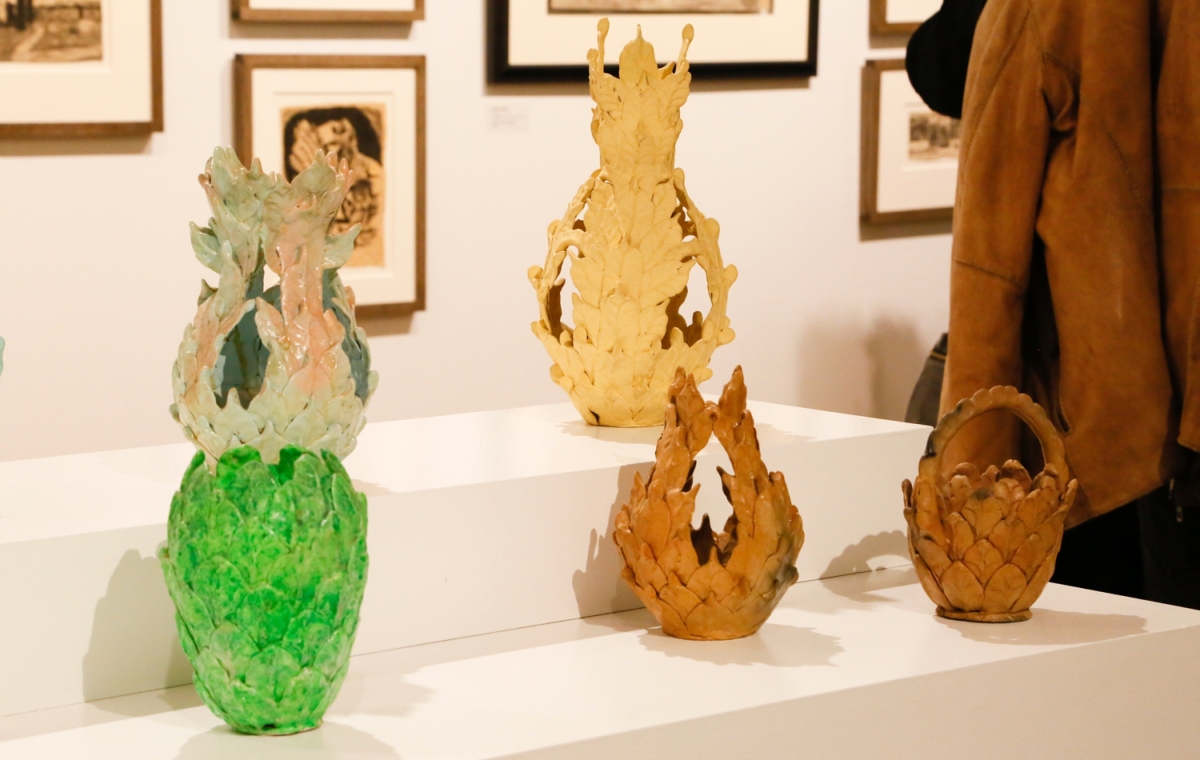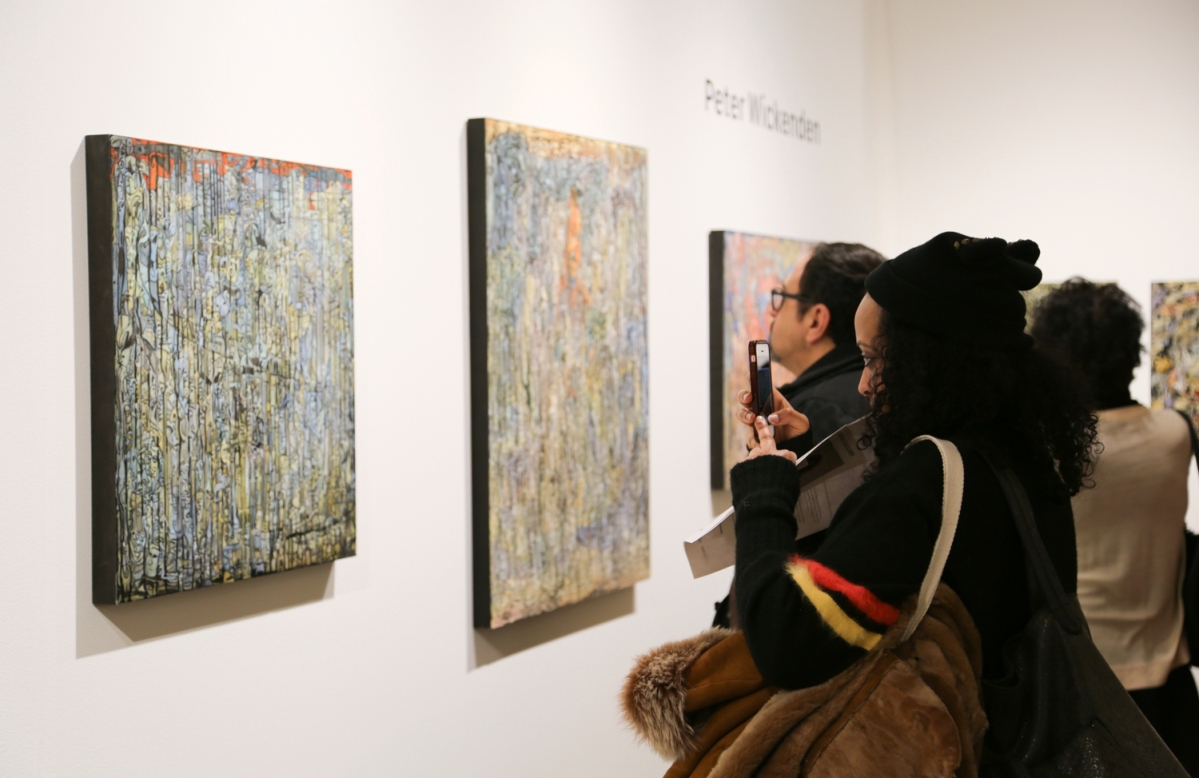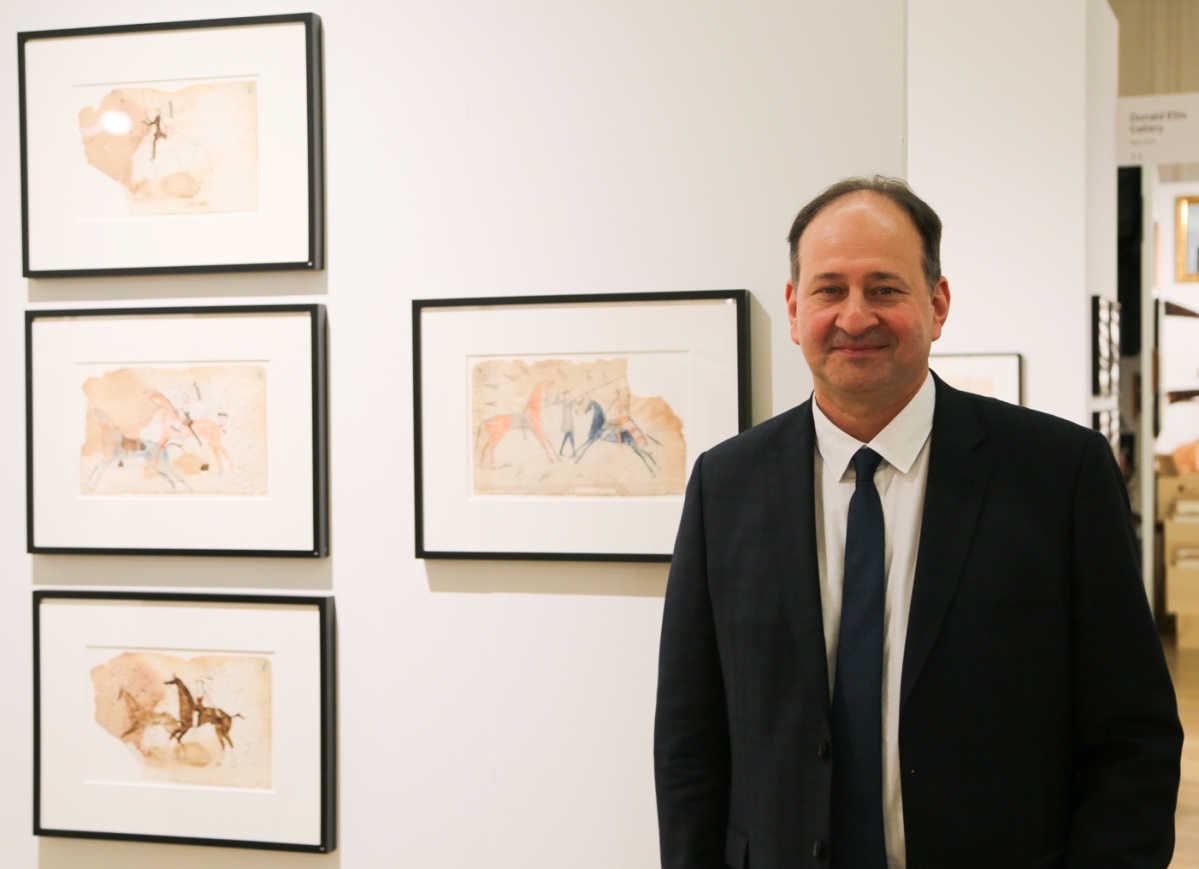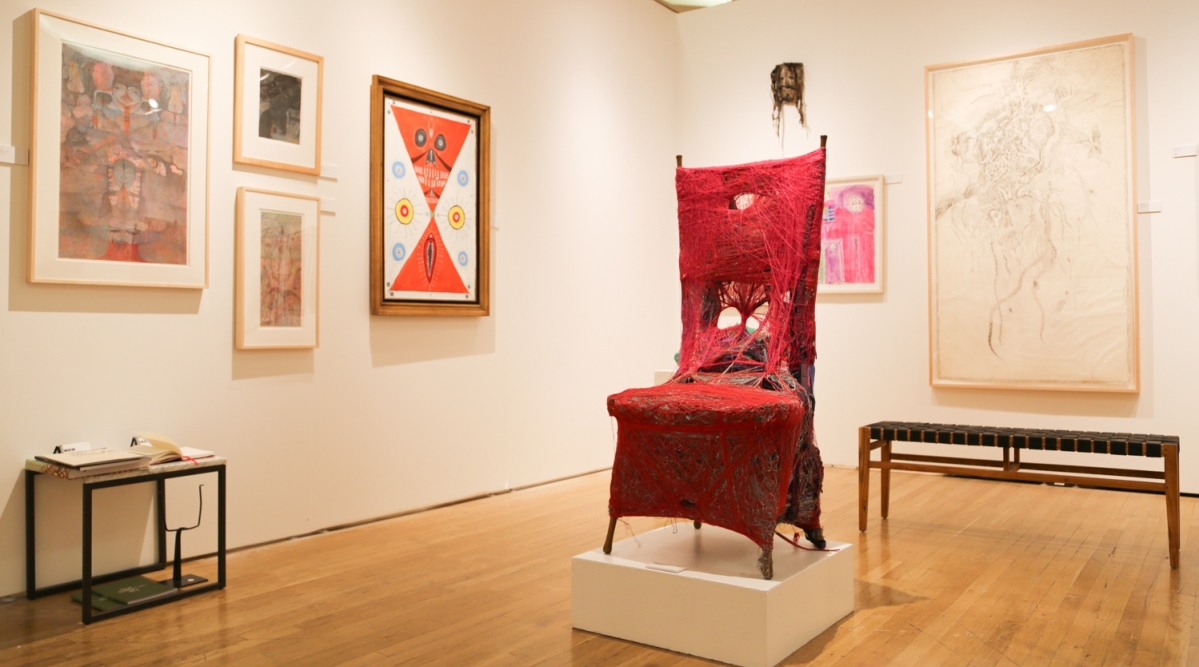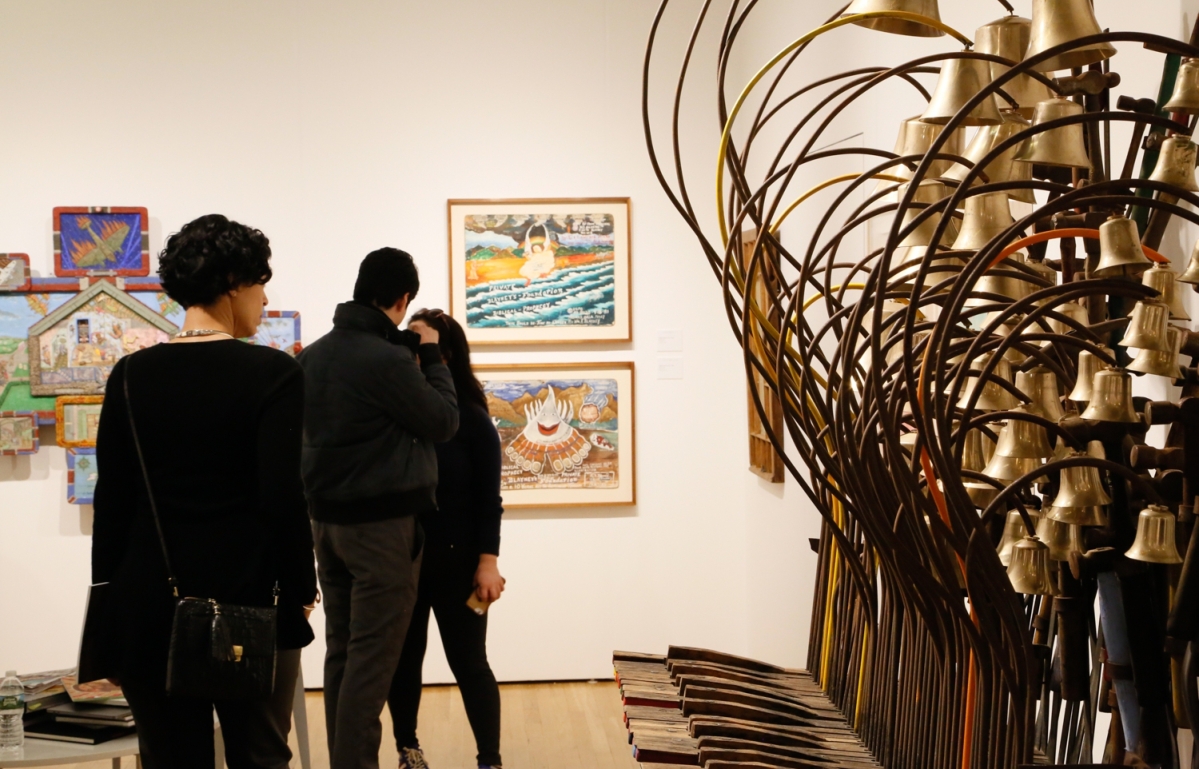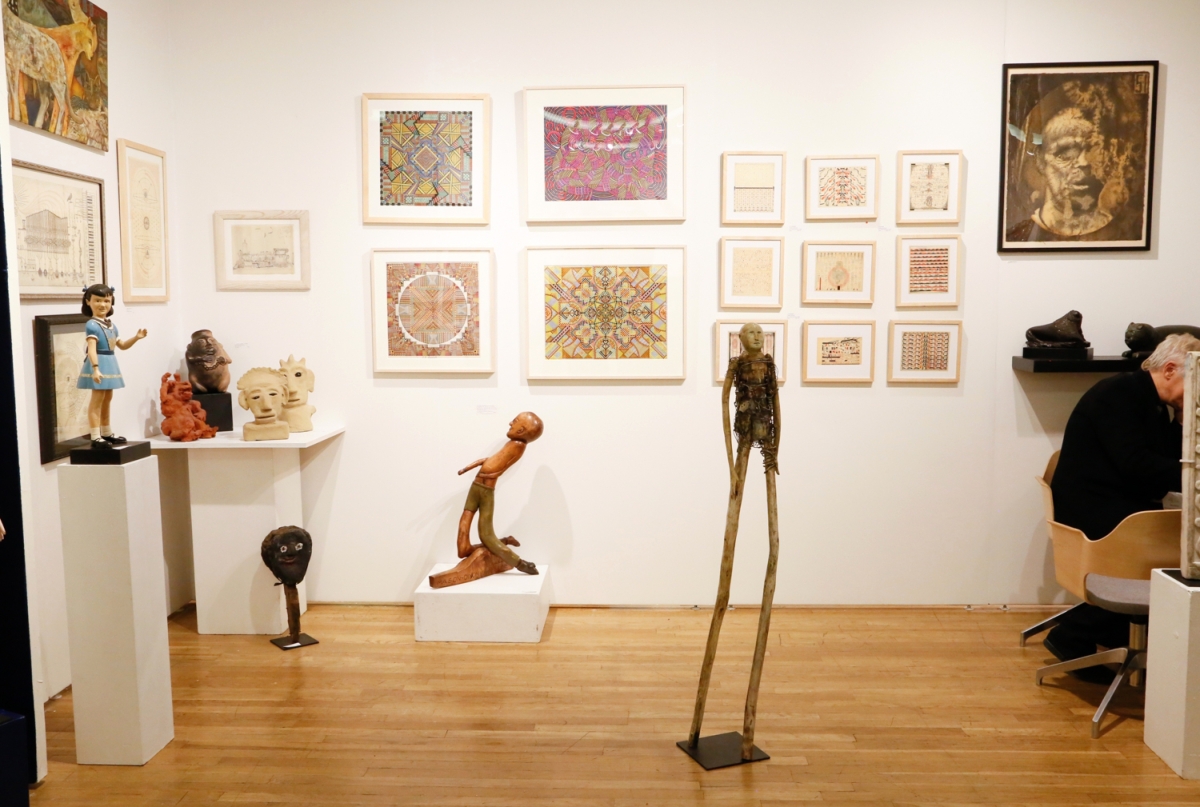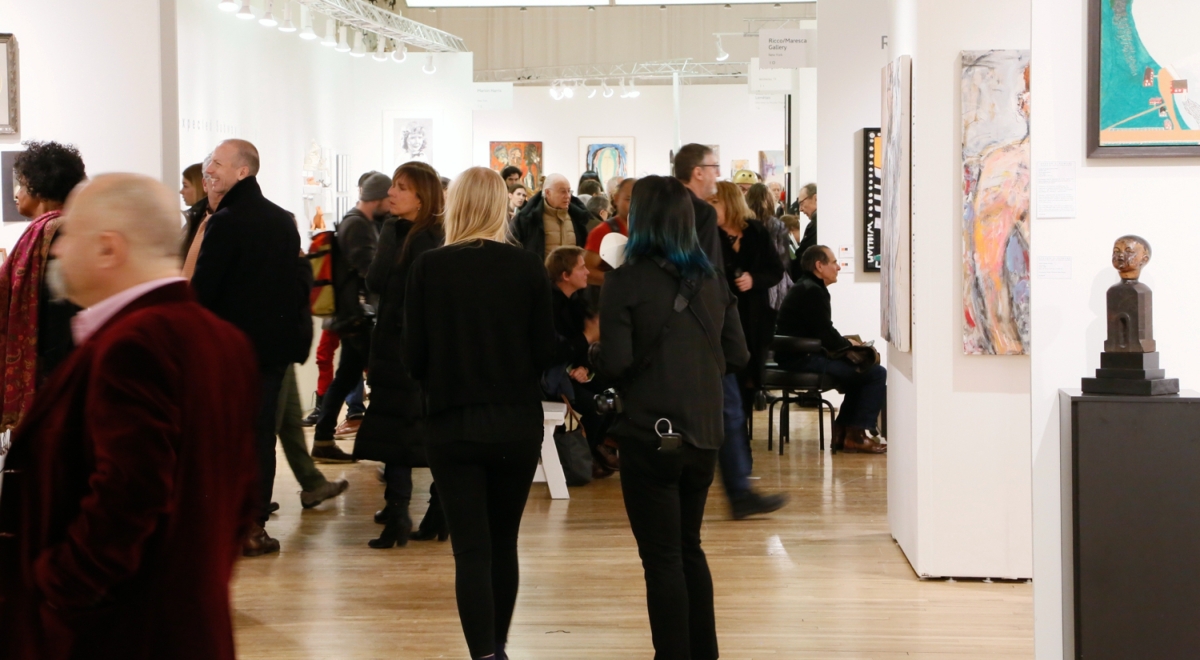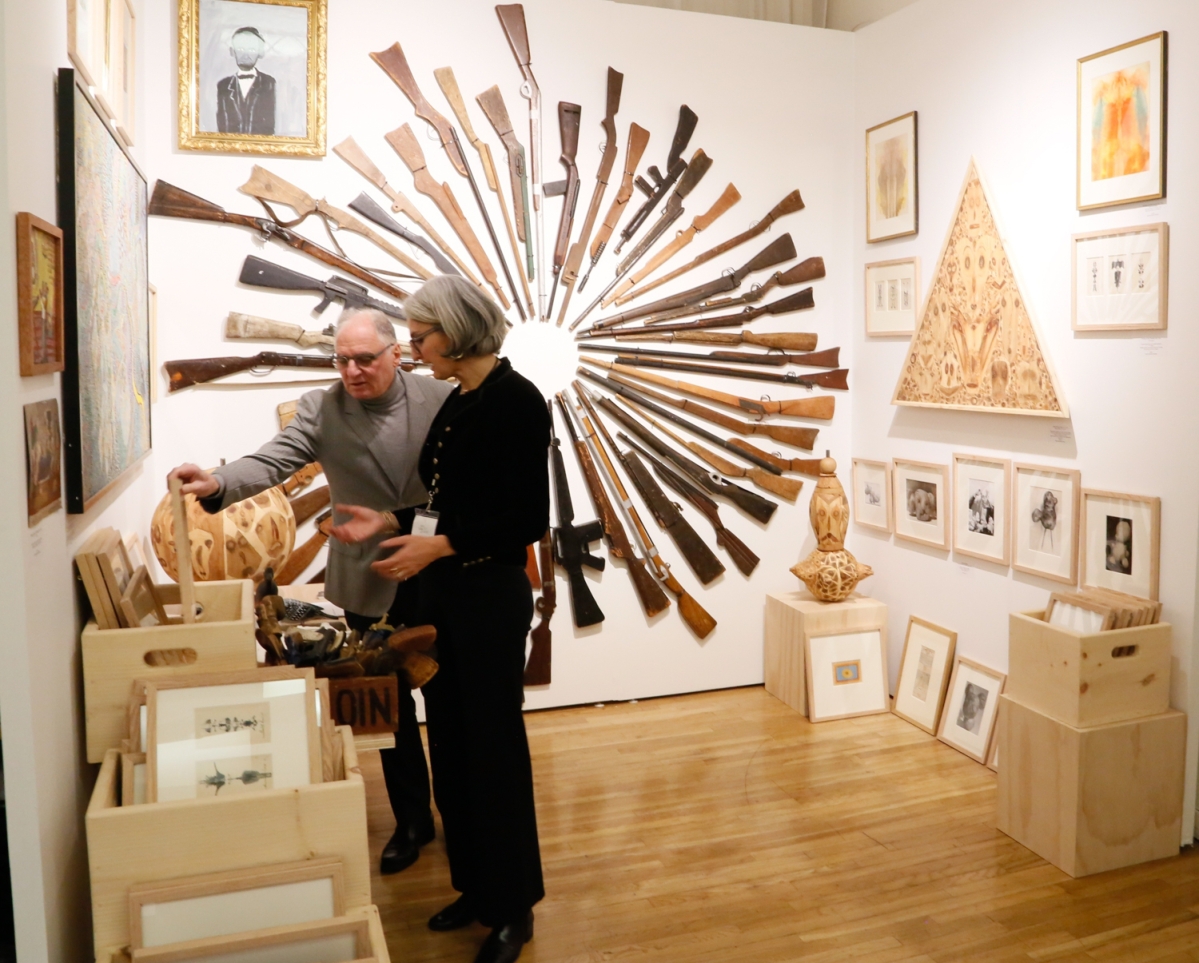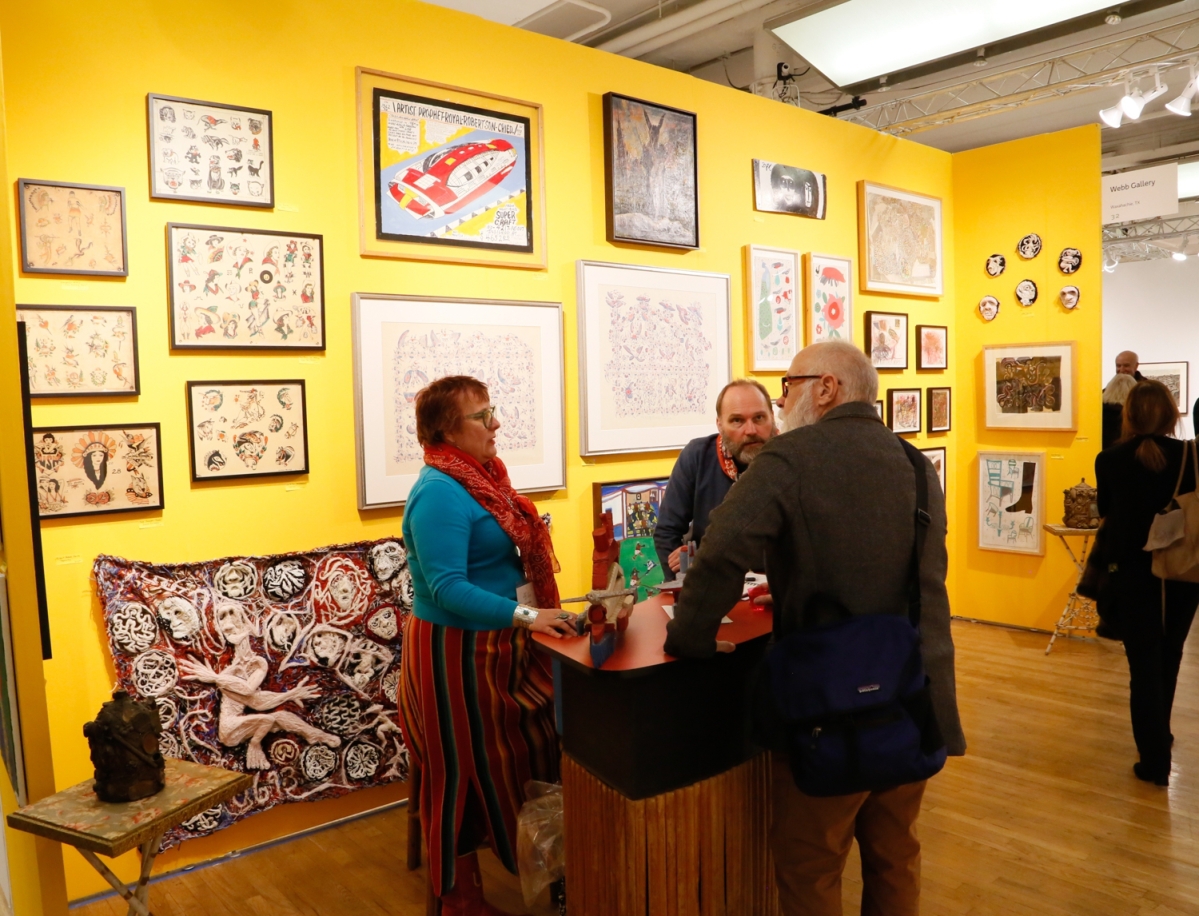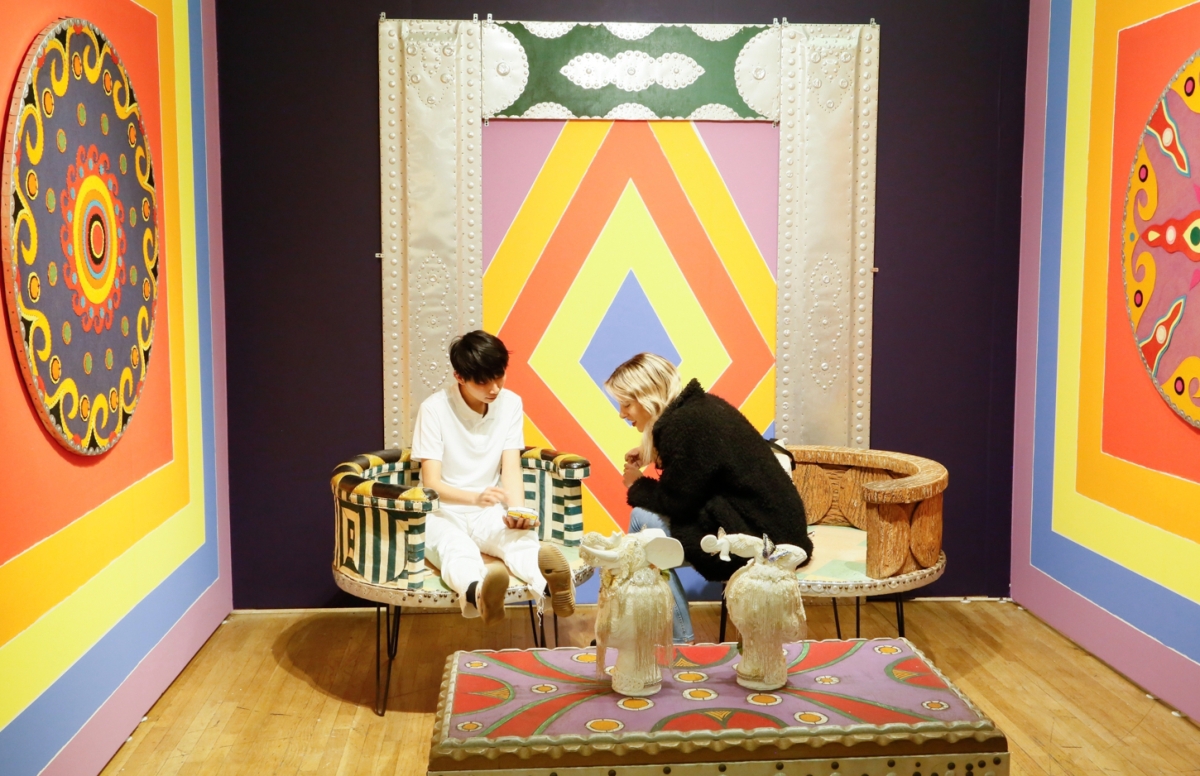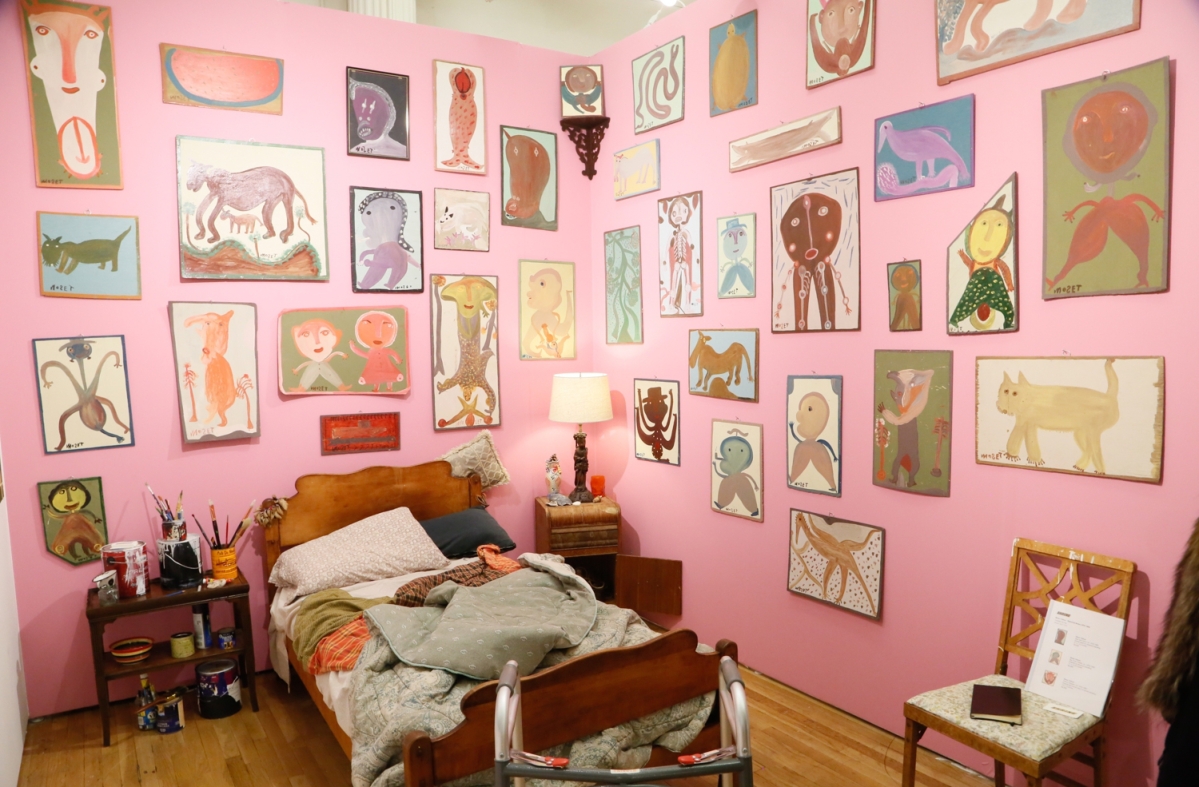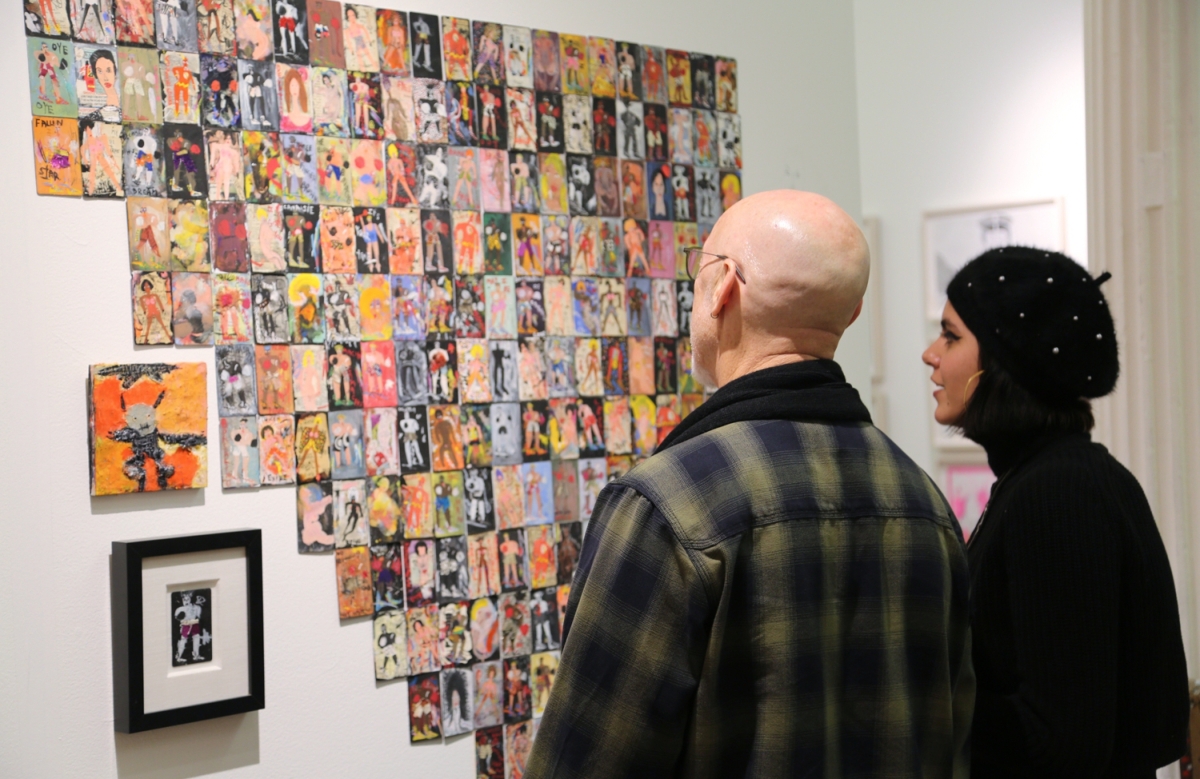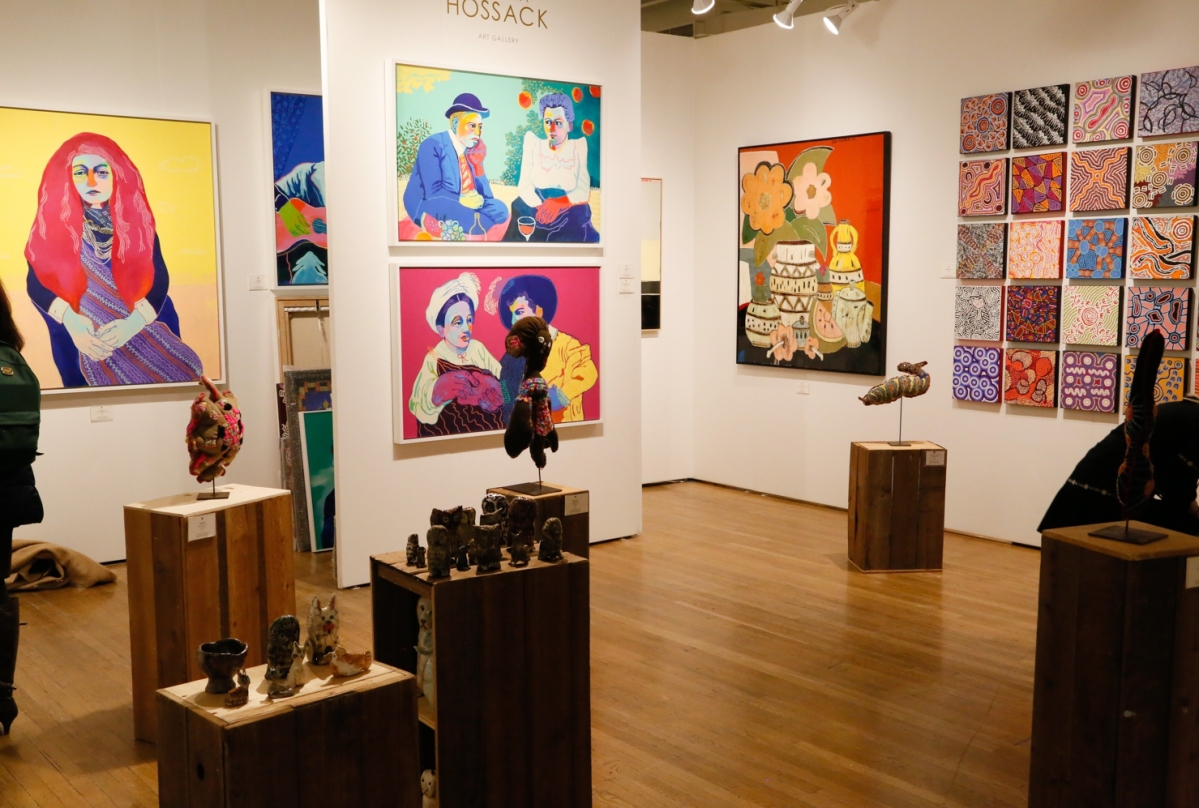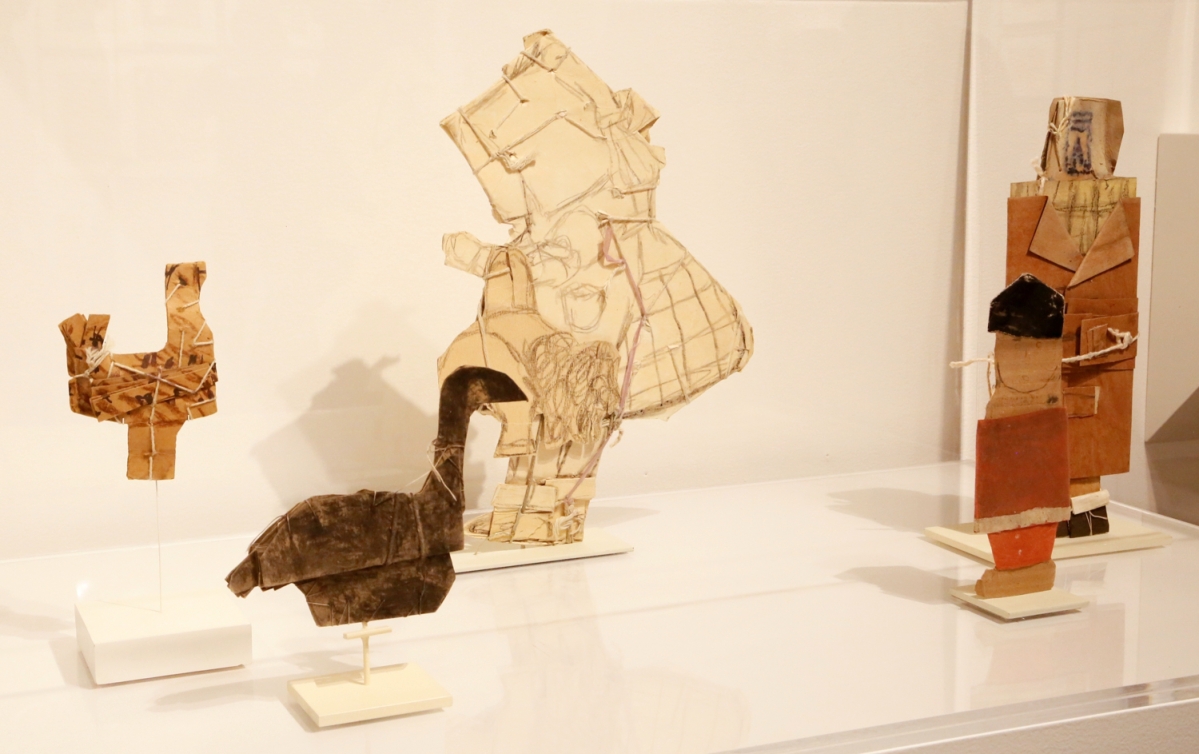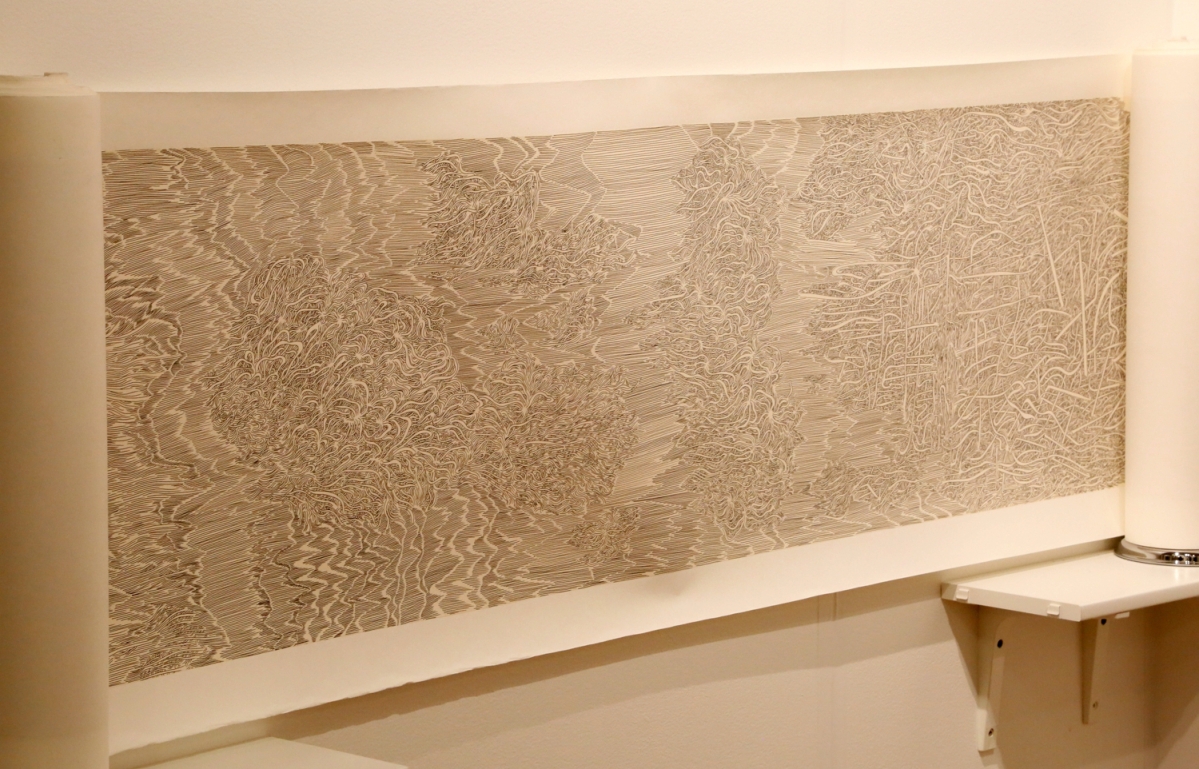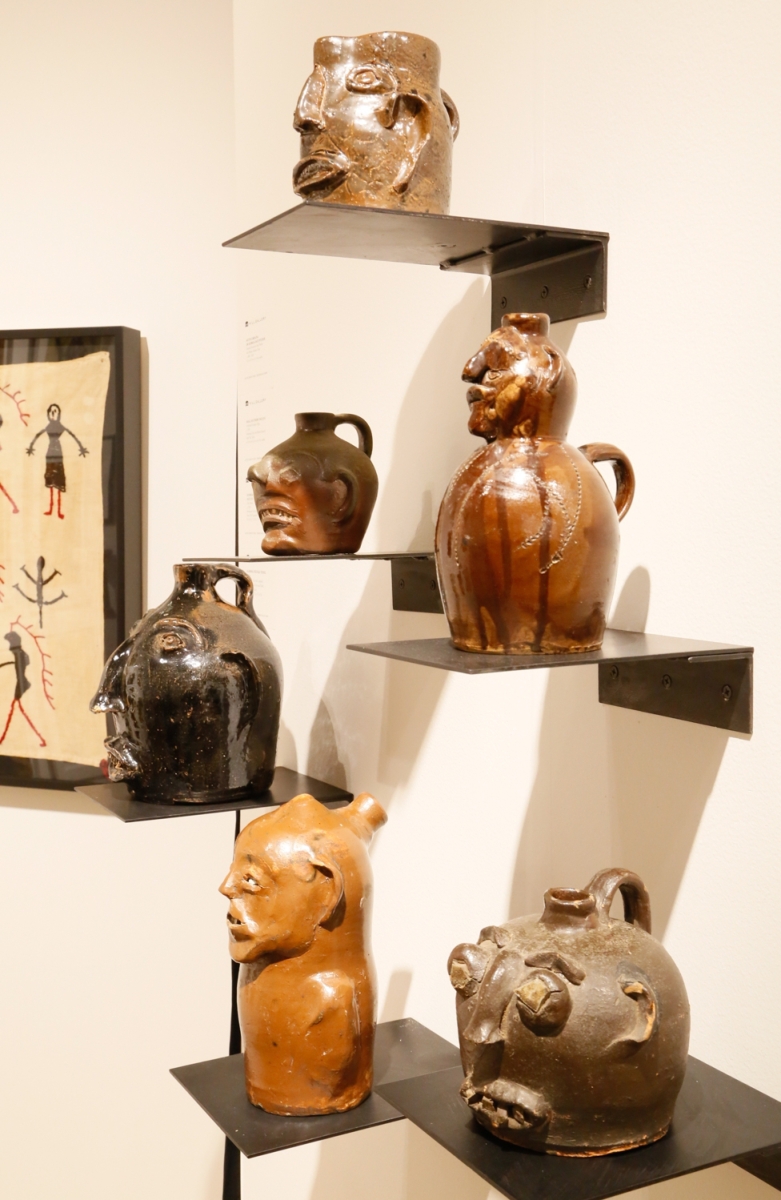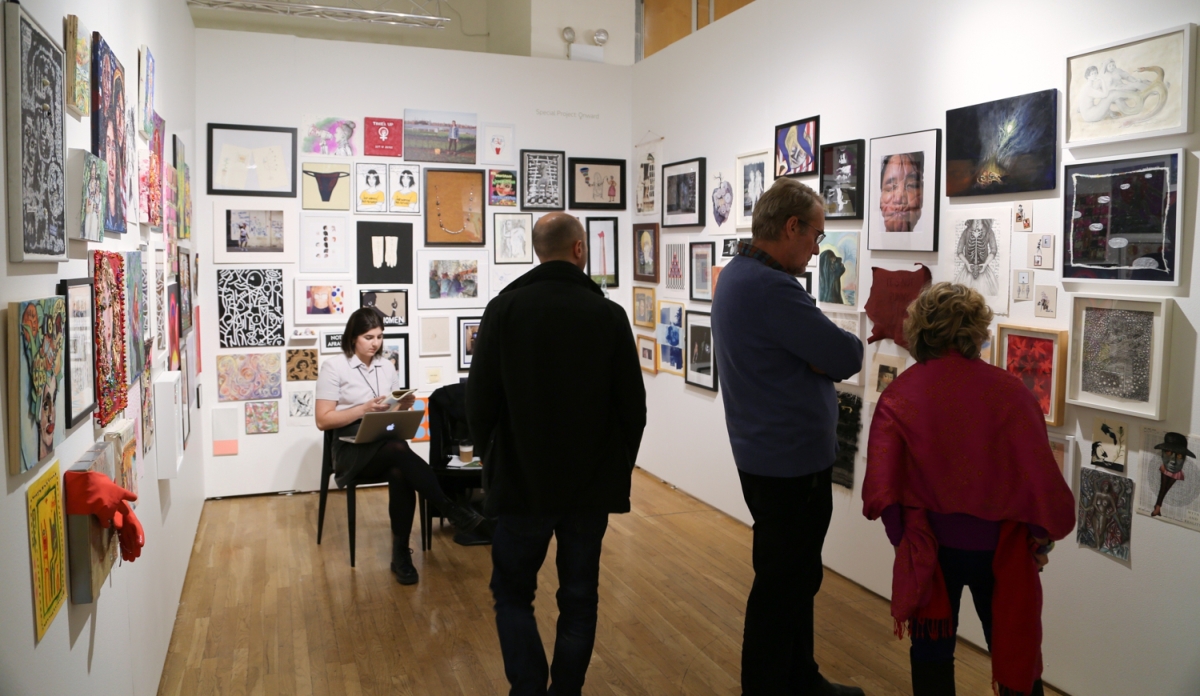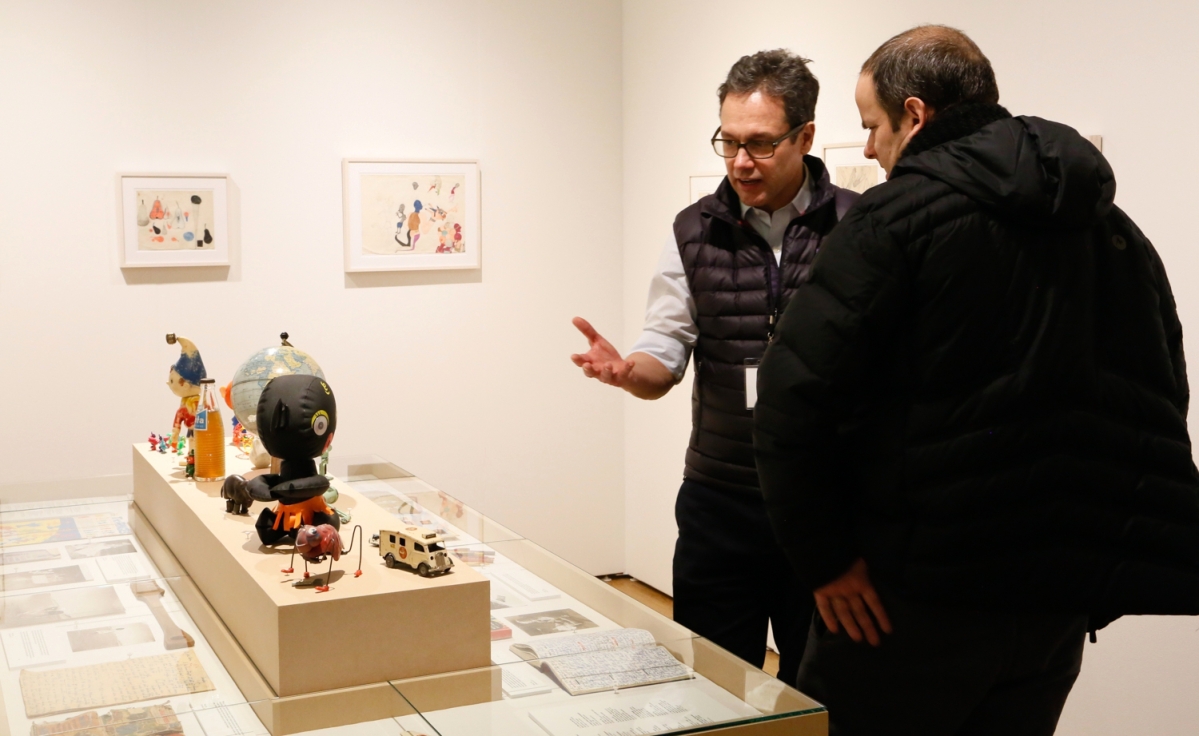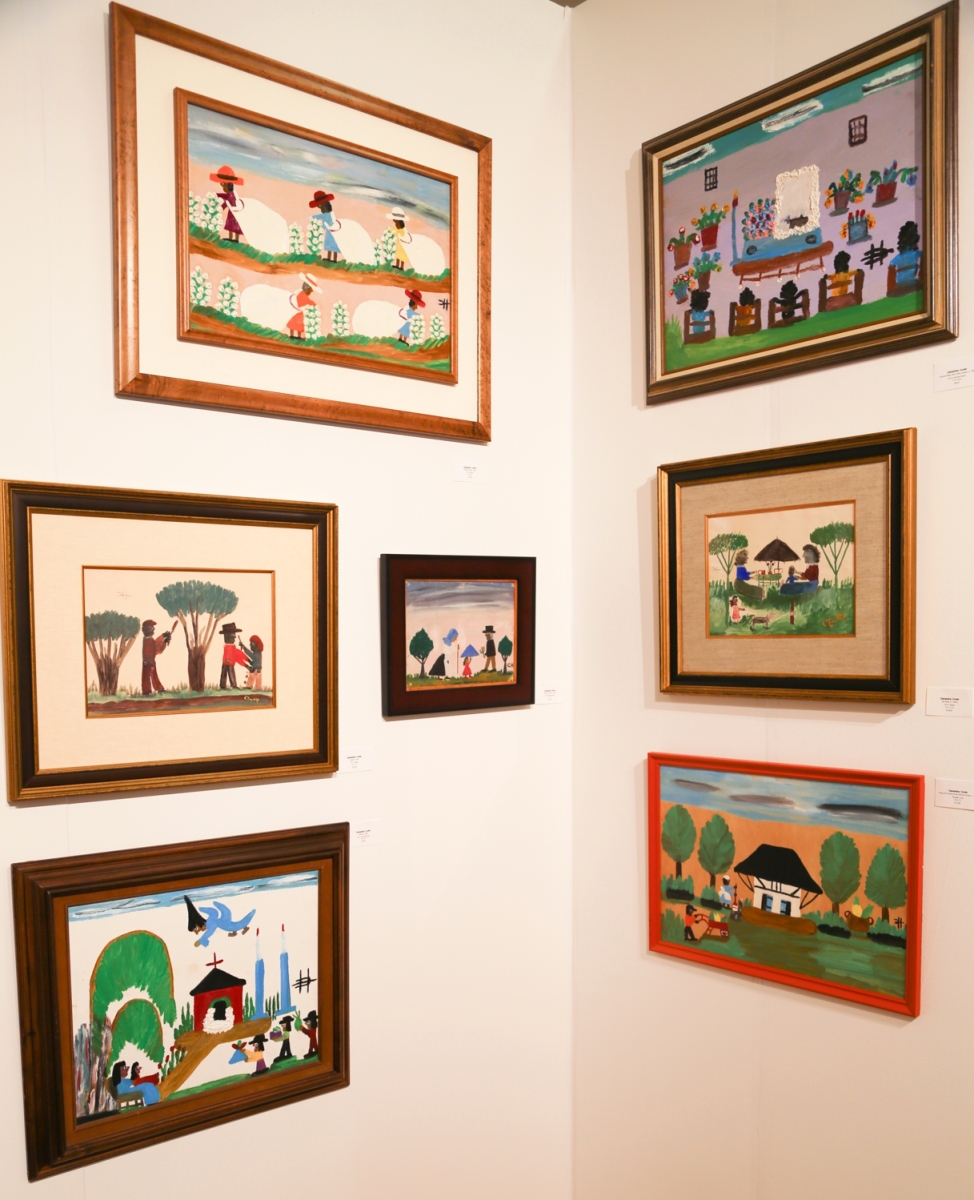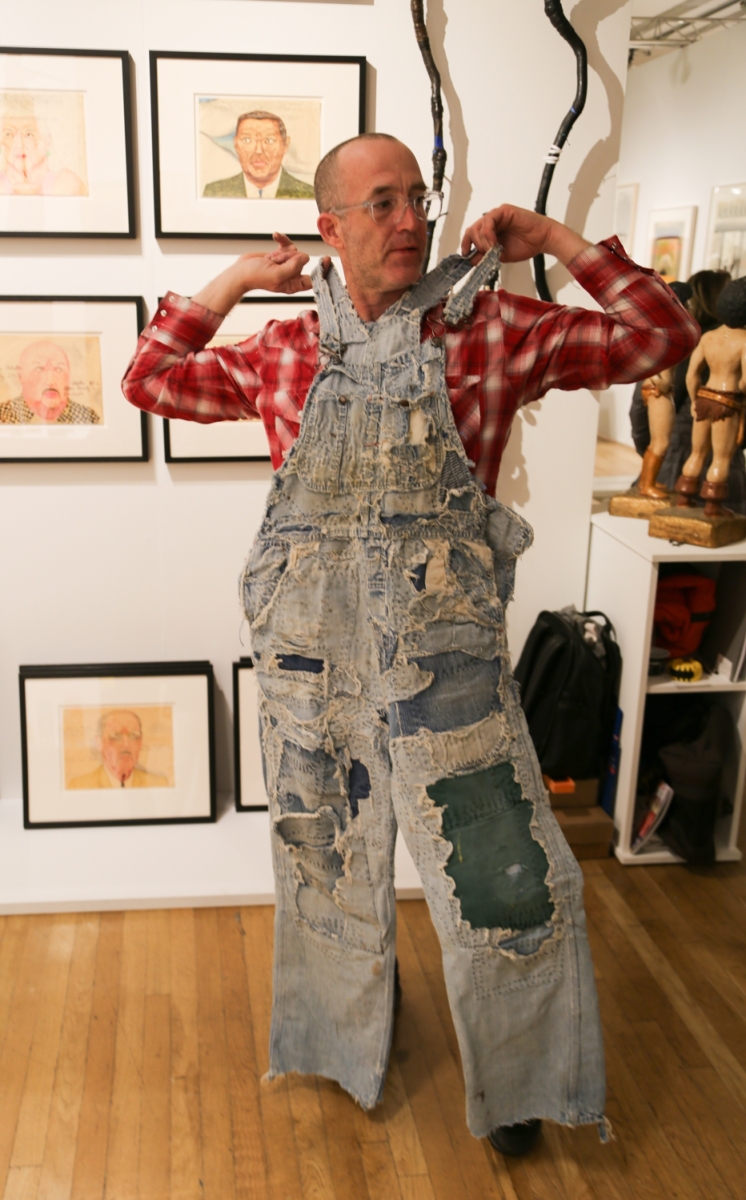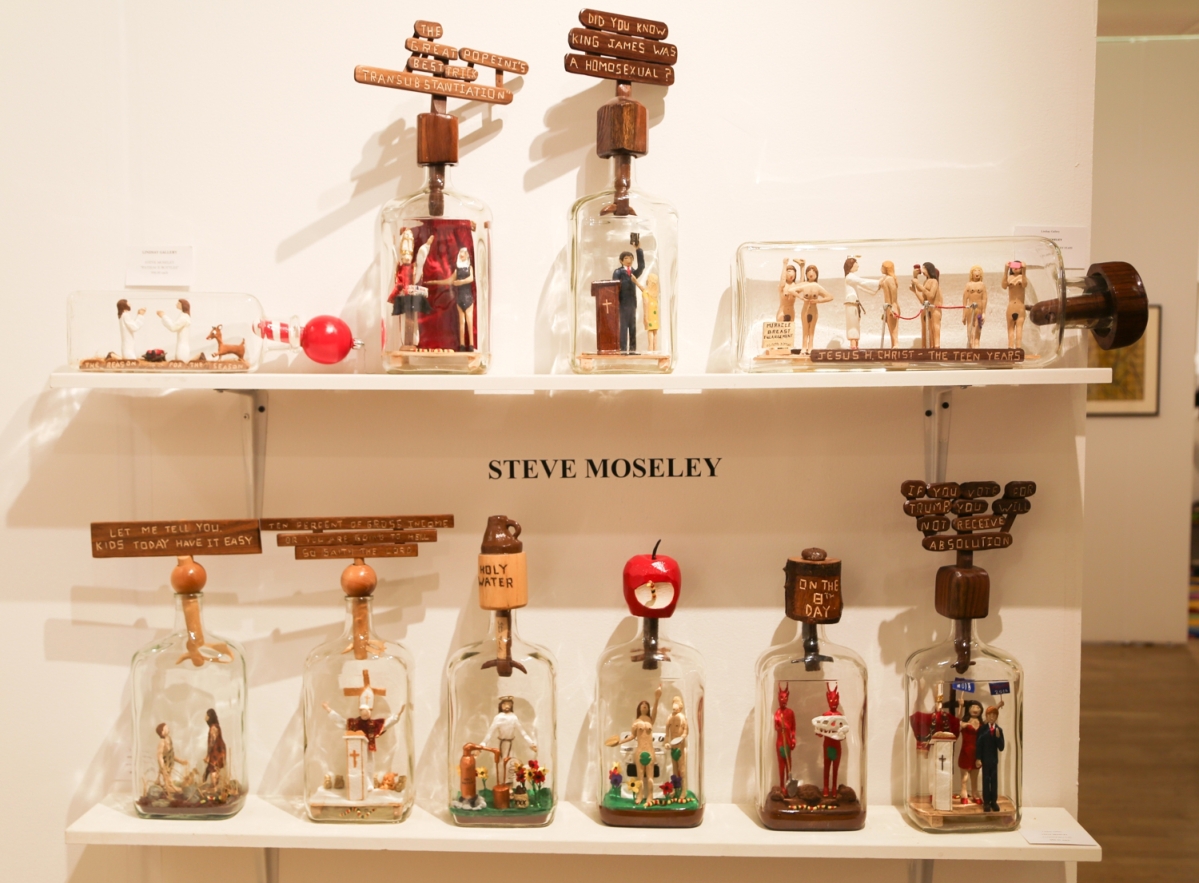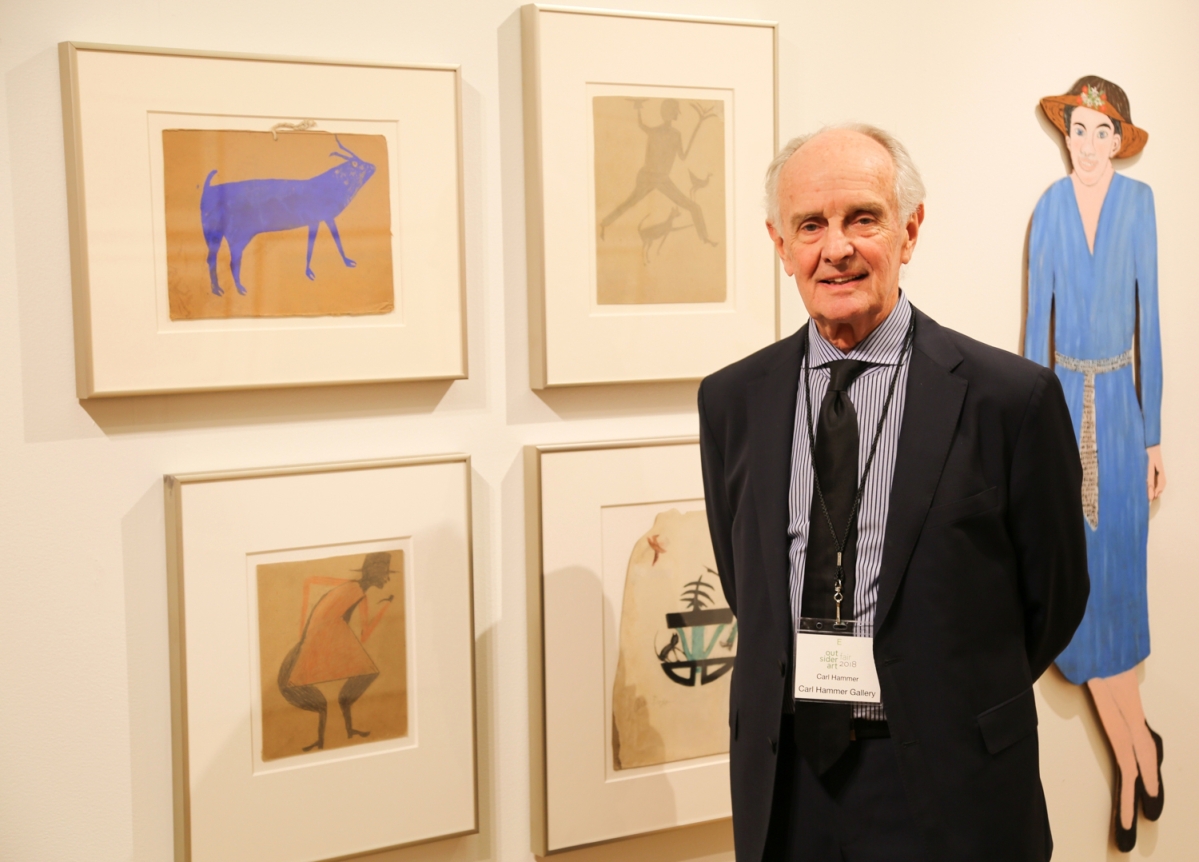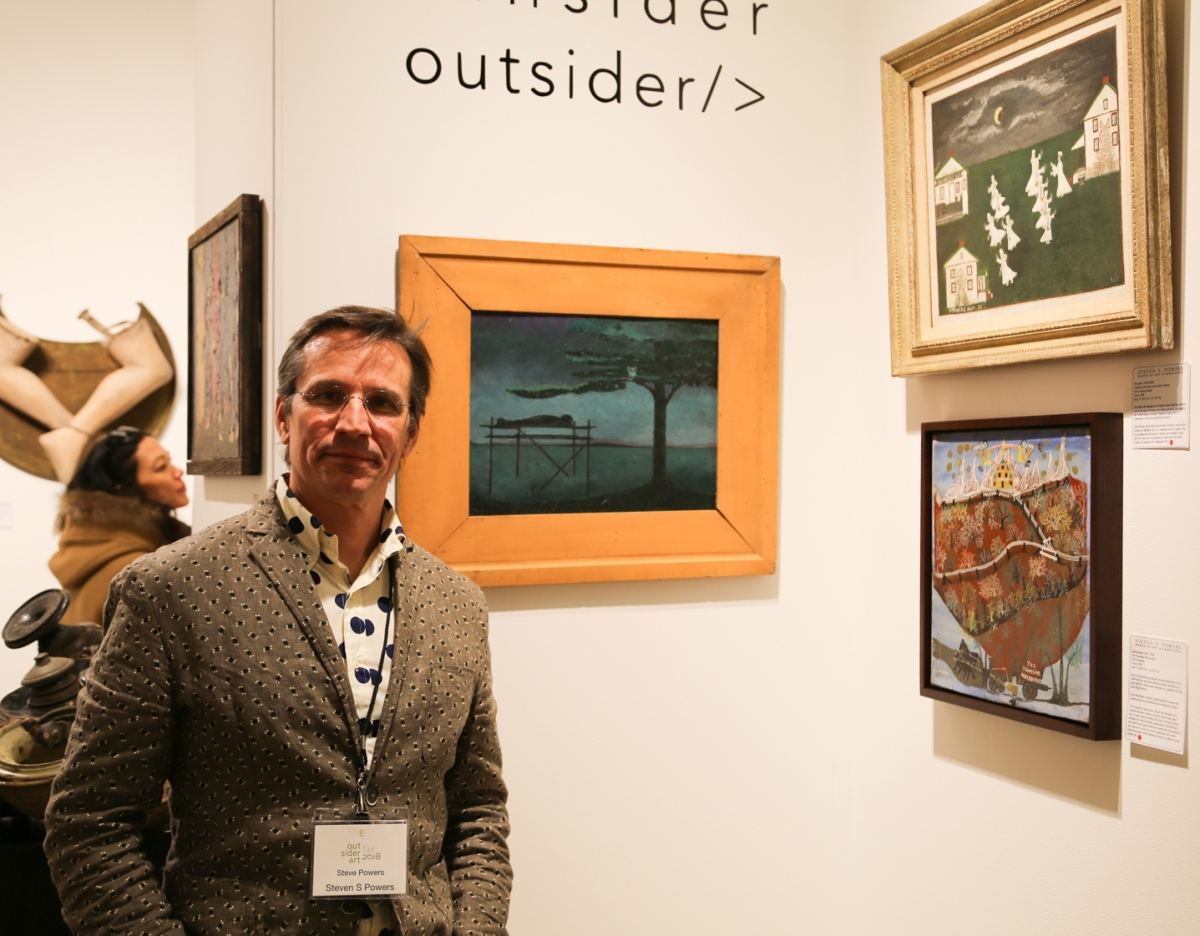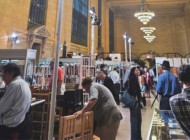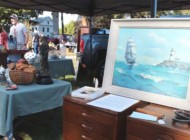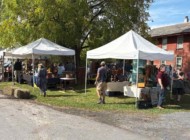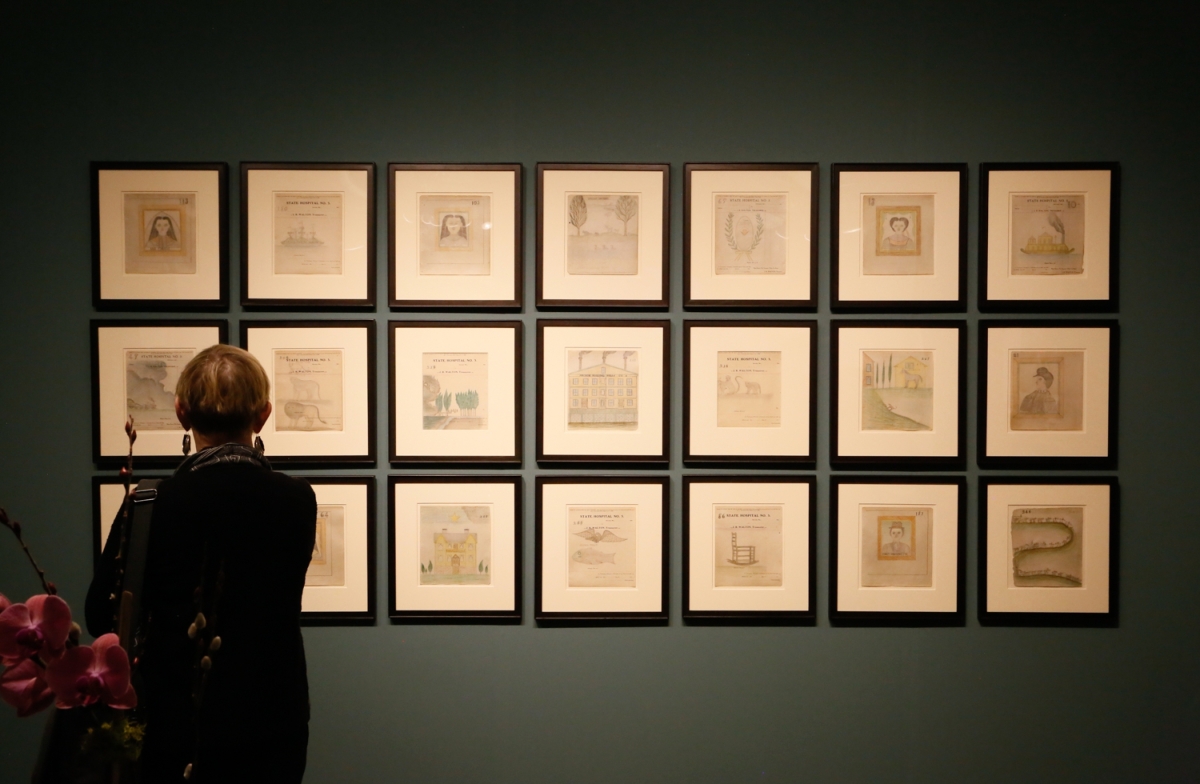
A selection of 21 works from Edward Deeds was on display at Hirschl & Adler, New York City. Deeds’ work was discovered by a young boy in 1970, when by chance he found a book of drawings in a street corner trash heap. The boy held onto the work for 36 years, when he brought them to a bookseller who listed them for sale online in 2006, reaching the Outsider art community.
Review and Photos by Greg Smith
NEW YORK CITY – It started in the mid-Twentieth Century and continued on through the patronage of those who believed. Much like any new art movement, Outsider art, or Art Brut as Dubuffet called it in 1948, organized itself outside the margins of the formal art world, which stood skeptical, arms crossed and with an eyebrow raised. Now 70 years since the genre began building, museum exhibitions are coming around, such as “Outliers And American Vanguard Art” at the National Gallery of Art, “Vestiges & Verse: Notes from the Newfangled Epic” at the American Folk Art Museum and Bill Traylor’s first retrospective, “Between Worlds: The Art of Bill Traylor,” opening at the Smithsonian in September of this year. Institutions and the greater public are beckoning at the door of the Outsider art world, asking for an invitation inside.
In the 26 years since its inception, there are perhaps only a handful of dealers and institutions that have promoted the genre for as long as the Outsider Art Fair has. Returning to the Metropolitan Pavilion for its January 18-21 run, the fair brought together a venerable selection of 63 galleries from seven countries to present a contemporary understanding of an ever-evolving field.
“I’m excited about the new young dealers,” said Andrew Edlin, show owner and dealer, who went from conversation to conversation with friends and clients as the show was just opening up. This show marks the sixth edition under Edlin’s belt, and he continues to bring in new names and galleries in an effort to expand name recognition and to bring international artists into the fold. “I love seeing new works and introducing people to something they’ve never seen before.”
New York City-based Hirschl & Adler brought a selection of 21 works by Edward Deeds, an artist who can be counted among the notable discoveries of the last 15 years. Deeds’ drawings, all crayon and pencil on paper, represent an idealized version of the world as seen from the grounds of State Hospital No. 3, a grand estate in Nevada that was erected under the Kirkbride plan, which saw sprawling utopian mental hospitals erected to rehabilitate patients under “moral treatment” plans. Deeds was committed to the hospital for dementia praecox and schizophrenia and would go on to draw an album of 283 works, many of them on the hospital’s ledger paper, in the 37 years that he lived there. His images span a range of traditional subjects including buildings, animals, objects and landscapes, but his primitive portraits, with their large, wide eyes and ghostly appearance, are perhaps the most memorable.
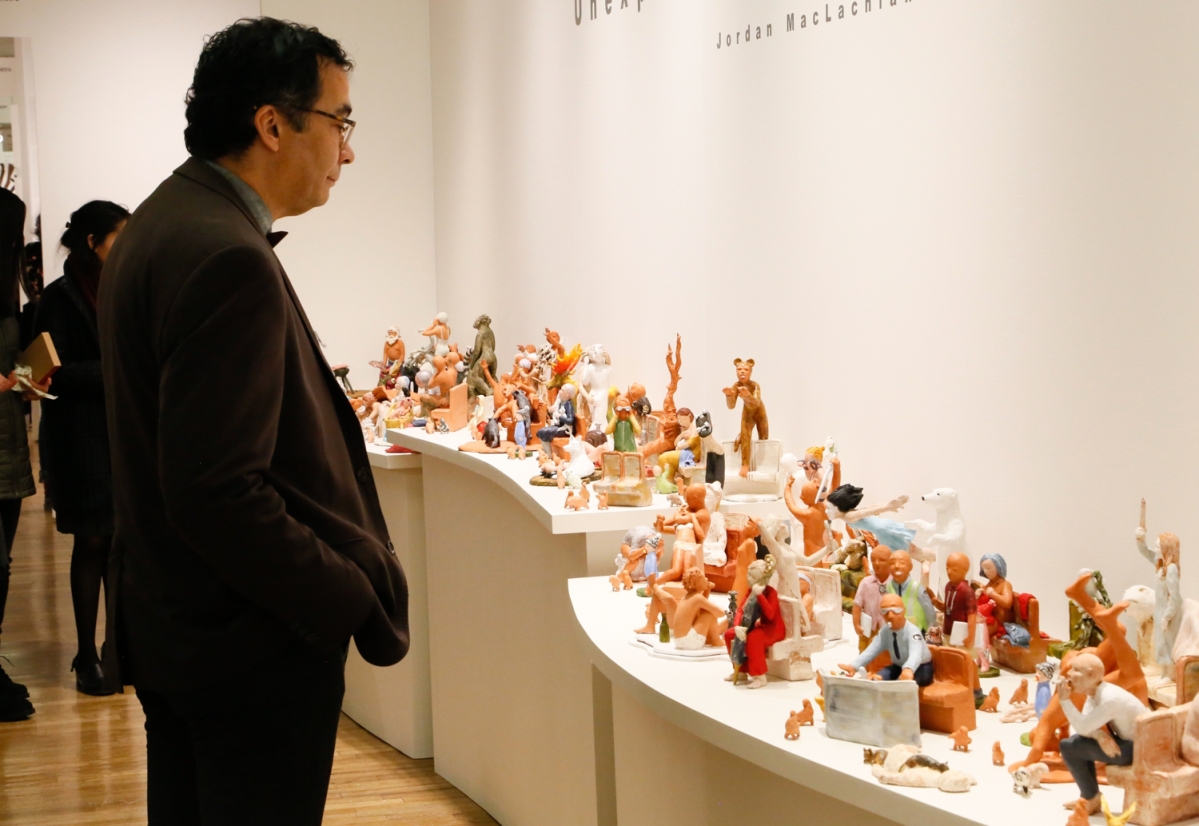
A man stops to take in Jordan MacLachlan’s “Unexpected Subway Living” series in the booth of Marion Harris, New York City.
Mose Tolliver was a late-blooming African American artist from Alabama who turned to painting after an accident left him disabled in the 1960s. Tolliver’s primitive paintings offer a Twentieth Century take on Southern folk art, focusing on flat portraits of humans and images of animals, sometimes trailing off into grotesque or spiritual subjects. New York City gallery Shrine brought together an exhibition of works by the artist, fashioning a scene of Tolliver’s bedroom, his unmade bed and nightstands set up in the center of the booth while his colorful paintings filled all available space on the walls.
Steven S. Powers, Brooklyn, presented his exhibition titled “Insider/Outsider,” which aimed to explore the classifications bestowed on a number of artists, both self-taught and formally trained, who he included in his exhibit. “Some of them have formal education in art, but through their sexuality or ethnicity, they come into it as an outsider,” he said. One of the paintings on his wall, which sold within the opening minutes of the show, was an oil painting by American artist Frank Colbert (1895-1953).
Colbert, a Chickasaw Indian and descended from a long lineage of Oklahoma landowners, opted in 1920 to move to Greenwich Village and pursue a career as an artist. Illustrated in news articles from the period, which prove to be some of the only records of Colbert’s art career according to Powers, the artist created a series of paintings on Indian folklore and showed in numerous exhibitions before moving to Paris in 1923, where he lost his momentum and suffered a breakdown. He returned to New York before heading back to Oklahoma, where he spent the last 12 years of his life in a mental hospital. Titled “The Train to Happy Hunting Ground,” Colbert’s painting, in subdued blues and blacks, was a primitive nocturne focusing on an open air scaffold burial that stood on the shores of a lake. A tree in the foreground depicts an owl perched on a branch, a symbol of the afterworld.
There was a slew of A-list names lining the walls of Hammer Galleries’ booth. The New York City and Chicago-based mainstay brought works by Sam Doyle, Howard Finster, Henry Darger, Joseph Yoakum, Simon Sparrow and Bill Traylor. As Carl Hammer surveyed the walls of his finished booth, he proclaimed his excitement to be back at the fair, saying, “I’m happy with what we brought and we’ll see what happens.” The dealer’s inventory always includes a variety of blue-chip names that have risen to prominence in the field. “I always bring the Traylors and Dargers because they transcend their genre,” he said. And indeed, Hammer pointed to the underpinnings of Traylor’s work that make them revered, their folky subjects and the subtleties of their geometric construction. “Traylor did some regal animals,” he said, pointing to the rambunctious dogs, wriggling snakes, playful cats and the high-flying birds found in the images on display.
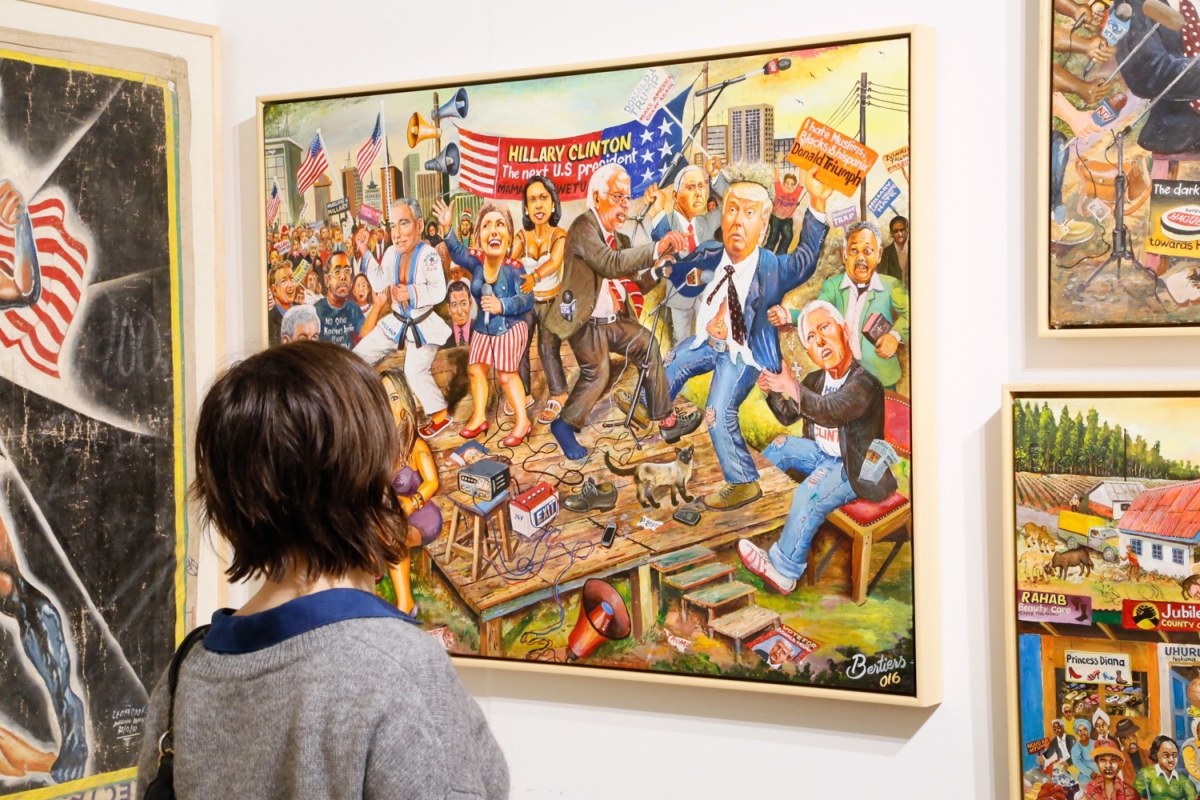
A viewer takes in a colorful and energetic work by Kenyan artist Joseph Bertiers in the booth of Ernie Wolfe Gallery, Los Angeles. Bertiers focuses on international politics and pop culture.
While our coverage of last year’s fair included the works of Jordan MacLachlan’s ceramic “Unexpected Subway Living” series in New York City dealer Marion Harris’ booth, the work’s expanded presence in Harris’ booth this year bears another look. MacLachlan’s fashioned universe, created under the pretense of a hostile world that pushed our continued existence into the subterranean transit tunnels, highlights a world where nothing is hidden and our depravities are laid out to witness. There is no privacy nor apology in these subjects as they live on in a shared and varied lifestyle, some subjects depicting a homely elderly couple sitting next to one another, others featuring erotic scenes, mythical beasts and professionals at work. The series fashions a vast universe of people, aliens, animals and organisms, all brought together in a chaotic circumstance that is endlessly entertaining to view together.
Americana enthusiasts who yearn for something infused with a modern dose of edginess would find solace in the works of Steve Moseley, who creates bottle whimseys focusing on sex, religion and politics. Rooted in the folk art tradition, Moseley fashions his own tools and inserts each piece, one at a time, into the bottle through the neck to create his humorous scenes. Examples that were featured in the booth of Lindsay Gallery, Columbus, Ohio, included a scene of Jesus creating holy water through a distillery, grown and adolescent cavemen looking at each other blankly under the age-old tag line “Let me tell you, kids today have it easy,” and another that features “Jesus H. Christ – The Teen Years,” where he can be seen running a miracle breast enlargement clinic.
Perhaps the single greatest quality of the genre, and one that resonates with storytellers everywhere, is that Outsider art is transportive. It does not exist within the confines of our collectively shared reality, nor within the norms of society; instead it whisks the viewer away into someone else’s fantasy world. The “who” and their life story is almost important as the “what.” That world is full of euphoric spirituality, manic depression, primitive representation and obscure Surrealism. And to boot, the net of Outsider art seems to be expanding, to include a wider variety of artists who worked, at their own pace, on the fringes of the established art world. There are great stories told at this fair; you need only to look at them.
For additional information, www.outsiderartfair.com or 212-337-3338.

